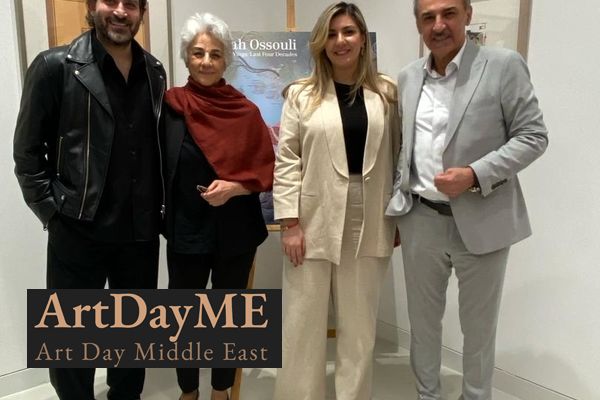Farah Ossouli's Book Unveiled at Foundry Dubai | Skira Published, Dastan and Bavan Unveiled
ArtDayME: On a beautiful winter evening at the Foundry by EMAAR in Dubai, the wonderful book Burning Wings: Last Four Decades, authored by prominent Iranian painter Farah Ossouli and published by Skira, one of the top publishing houses in the art world, was unveiled.
Ossouli is well-known throughout the world for her modern take on the miniature, and notable institutions like the Metropolitan Museum of Art in New York possess her creations.
Dastan and Bavan galleries presented Burning Wings: Last Four Decades at the "Present Illuminations" exhibit, which presently includes three of Ossouli's pieces.
The book launch gathering was planned by the exhibition curator, Takin Aghdashloo.
The first speaker of the event was Ava Ayoubi, the director of Bavan Gallery, who described the book's release by Skira publishing house as evidence of the remarkable talents of Iranian women artists.
Subsequently, Aghdashloo read from a biography of Ossouli, noting that in addition to painting, she is commonly recognized for her work in theater, film, and graphics.
Then, the remarks of Necmi Sönmez, a Turkish curator, art critic, and Skira publishing company art specialist, were shown on video. Examining Ossouli's diverse professions, he extolled her, characterizing this modern interpretation of classical art as a creative revolution.
The Dastan Gallery representative Sam Roknivand also complimented Ossouli on a lifetime of artistic accomplishment.
Ossouli made a brief statement in which she discussed the social issues that significantly altered her artistic life. She noted that due to her enthusiasm for Iran and the Iranian youth of today, she has remained in her homeland.
Following the ceremony, there was a book signing for Burning Wings: Last Four Decades.
Among the artists in attendance were Alireza Sami Azar, Giuseppe Moscatello, Maryam Masoudi, Yasmin Sinaei,Iman Safaei, and Elham Pourkhani.
Part of Takin Aghdashloo's speech at the launch of Farah Ossouli's book
Farah Ossouli started her art practice while studying Graphic Design at the College of Fine Arts at University of Tehran. In the beginning of her art practice, she wasn’t enthusiastic about Persian miniatures, regarding the art form as antiquated and at times crude, but she eventually discovered the
historical masterpieces of Persian miniatures, and with encouragement by her friend Gizella Varga Sinai, decided to adapt this traditional painting style to narrate contemporary concepts.
It is worth mentioning that Farah Ossouli is one of the few artists of her generation who stayed in Iran after the 1979 Revolution, and continued to work as a professional artist, in a period of enormous uncertainty and total shutdown of the art scene; from universities to galleries and museums, for nearly 10 years. In order to grasp how limited the art scene was in this period, it is astonishing to note that her first two solo exhibitions were respectively at her house, and then at the residence of the German ambassador in Tehran, until 1989 when galleries were able to function again and she held her first public solo exhibition at Seyhoun Gallery.
In 1984, Ossouli did a series of miniature paintings for her late husband, the distinguished Iranian filmmaker Khosrow Sinai’s film Neyshabour, channeling her sentiments about the Revolution, acts of terror, violence and the ensuing Iran-Iraq War, and there it all began. Since then, she has transformed Persian miniatures, successfully adapting its style and aesthetics, while drawing inspiration from a wide range of sources, from Persian classical and modern poetry such as Hafez and Foroush Farrokhzad, or creating reinterpretations of great masters of European painting such as Lenoardo Da Vinci and Francisco Goya. Today, after four decades, she is considered a pioneer of melding Persian miniatures with contemporary themes and concepts, and she is credited with being one of the primary artists who revived the traditional art form.
Farah Ossouli’s influence on female representation in Iranian visual arts isn’t limited to her own art practice. Other pioneering achievements I should note include the establishment of the first all woman art collective in Iran, titled DENA in 2001, and becoming the first female curator of the Tehran Painting Biennial in 2003.
Ossouli’s work can be divided into three periods, gradually shifting from more personal narratives to more political ones. She uses varying techniques from the seventeenth century Isfahan school of painting and delineating, to experimenting with and introducing flat surfaces and patterns painted with airbrush. Her latter works such as the Listen! Do You Hear the Darkness Blowing? series is inspired by socio-political developments in Iran and the Middle East, mainly the mass protests of 2009 in Iran, and the Arab Spring, criticizing authoritarianism and oppression in a more direct, poignant and subversive approach.
Farah Ossouli’s work have been presented in numerous solo and group exhibitions in Iran and internationally, and are held at permanent collections of major art institutions including Los Angeles County Museum of Art; The Metropolitan Museum of Art in New York; Devi Art Foundation in New Delhi; Tropen Museum in Amsterdam; Ludwig Museum in Koblenz, Germany, and the Tehran Museum of Contemporary Art.




























LEAVE A RELPY